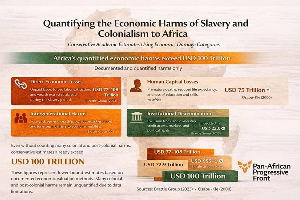What a shame
Canadian Epoch Times correspondent Zoë Ackah, writing (and photographing) from Ghana.(Zoë Ackah/The Epoch Times)
KUMASI, Ghana—I know what you're all wondering. What am I bringing you from Africa? It wasn't easy getting that perfect gift for each friend and family member, let alone each reader. I set out by following my own advice. I went to buy each and every female friend a two-yard cloth. Imagine my surprise when I found the vast majority of "African fabric" is now made in China. "What is the purpose of buying something made in China as a souvenir of a trip to Ghana?" I asked the cloth seller in Central Market. "But the quality is good," she replied. Not to mention the fact that the Chinese made prints are exactly half the price of those made by Ghana Textile Products. I bought the Ghana Textile fabric anyway. Of course, I've always refused to buy the top quality fabric here called Hollandaise or Holland wax. (The very best African prints are made in Holland, of course.) Why would I support colonialism? Stupid me. I later learned Ghana Textiles is a subsidiary of the Dutch-owned Vlisco. I began to feel queasy. I decided to buy some of the cheap Togo fabric people sell on their heads. Ghanaians go to neighbouring Togo to buy fabric. Somehow, I though maybe the Togolese still make fabric. Stupid me. I later learned the Togo fabric is actually smuggled into Ghana. Why smuggled? It is a matter of copyright infringement. You see African fabric print design is highly competitive. As soon as a fabric design from Ghana is selling well, someone will take a piece of it to China, have the print cheaply duplicated, and run yards of the knock-off at half the price. I guess the Hollywood elite aren't the only ones being bled dry by Chinese copyright infringement. They're just able to afford lawyers a team of public relations experts. Read all Zöe Ackah's adventures at West African Journal By this point, I was feeling sickened. Then it happened. I got lost in Central Market, an experience that was pleasant eight out of 10 times it happened to me. Somehow, I stumbled upon the alley where the kente weavers bring in their wares from the countryside. Kente is the hand-woven local fabric. It is woven in tiny strips and sewn together to make clothing. Kente comes in hundreds of intricate patterns, each bearing a name. This beautiful fabric is one of Ghana's most powerful national symbols. Colourful, detailed, and of the highest quality, traders from Cote d'Ivoire and even Nigeria visit this tiny alley in Central Market to buy kente. I select 30 single pieces—ends really. Each is different and just the right size for a unisex scarf. The new styles of kente are hot pink and turquoise blue. The piece I bought for myself was the cheapest of all—a piece of kente at least 50 years old called "someone could easily block your way." I remind myself not to let anyone block my way in life! It is so old and beautiful. I feel like a smuggler, removing a tiny peace of Ghana's precious heritage. If only someone had the sense to search my bag for antique kente and charge me. Ghanaians, think about it.
Emperor's Old Clothes: Like the African Beads? They are antique, and not African at all. These two strings of "trade beads" made in Europe are at least 100 years old and may have been exchanged for slaves. (Zoë Ackah/The Epoch Times) Evil Beads Having found my way out of complicity with the neo-colonial forces, albeit temporarily, I decide to buy the other cultural staple here—beads. There are plenty of colourful locally made beads. As I make my way through the bead alley, I come across the shop with the most variety. I select some local bracelets and some Ghanaian made beads women wear on their waists. They are made from colourful glass. Some are smooth; some are rough. For myself, I buy the very best. The most expensive beads are old and made in Italy, Holland, England, or Germany. They are trade beads. I heard the whole story from a bead trader named Bawa who inherited his bead stall in Central Market from his mother. You see, the traditional African beads are earthen, brown and simple. It was the Europeans who came with colourful porcelain trade beads. These beads come in a number of styles, and you can still buy them, though some may be 200 or 300 years old. These are the beads that were traded for gold, salt, and human beings. These beads accompanied the smallpox-tainted blankets and the shabby land treaties that led to near annihilation of North America's indigenous population. I bought mine for $7. You see, something that has cost immeasurable human suffering is still so cheap! Looking for souvenirs of Ghana's culture, I found one of our own culture, and it was condemning. Taking a Closer Look You may be wondering why there are no photos of the wizened bead seller, the silver haired kente salesman or the obese cloth kiosk clerk. The answer is I didn't have the heart. Somehow it would have been objectification of a people who have had enough of being "exotic," "spectacular, " and "weird." If I were in Holland, writing about my trip there, I may well have shoved my camera into locals' faces and said, "Swiss Cheese!" because the history is different. The Dutch and the Swiss were never our slaves. In fact, the Western world is still enjoying the riches slavery and the subjugation of Africa have brought us. Colonial powers have had hundreds of years to effectively crush the confidence of this continent. We sought to ridicule African culture into non-existence with such effectiveness that often the local people here paint themselves, and everything that represents them, with an air of inferiority. There is little or no appreciation for the cultural fixtures that are holding this place together, unless you look to the circle of local intellectuals, and they are facing an uphill battle.
Well Heeled: These traditional sandals are custom fitted. I bought a pair for $7, but most people now wear the $1 flip-flops from China—a pity really, as these last more than 7 times longer. (Zoë Ackah/The Epoch Times) The traditional music and dancing here are seen as antithetical to the church, and therefore evil (UNESCO World Heritage Status aside). Wearing kente is seen as something old people do. One shopkeeper tried to convince me that some beads, clearly made in Ghana, were made in London, the assumption being Ghanaian goods must be cheap and second-rate. The fantastic locally made black paten leather sandals are all stamped "Made in Italy," or even "Made in China." As I prepare to say goodbye to Ghana, it saddens me that many of the things I have come to love about this country are under attack by the very people who should be their dedicated, stalwart custodians. There is just too much here to treasure! Just as we ultimately must share the blame for devaluing the wonderful culture here, likewise we must share the responsibility of keeping it alive. That is why I invite you all to visit Ghana, and bring your tourist dollars. You will learn more than you can imagine, and you most certainly will have a wonderful time.

Views expressed by the author(s) do not necessarily reflect those of GhanaHomePage.














